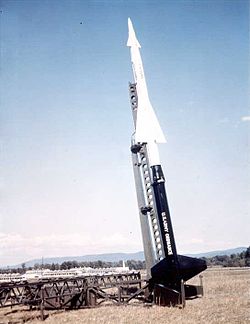
Back Nike Ajax German MIM-3 Nike Ajax Spanish Nike-Ajax Finnish MIM-3 Nike Ajax French MIM-3 Nike Ajax ID MIM-3 Nike Ajax Italian MIM-3 (ミサイル) Japanese Nike Ajax Dutch MIM-3 Nike Ajax Portuguese MIM-3 Nike Ajax Russian
| Nike Ajax | |
|---|---|
 A Nike Ajax in firing position. | |
| Type | Surface-to-air missile |
| Place of origin | United States |
| Service history | |
| In service | 1954–1970 |
| Used by | United States Army and allies |
| Production history | |
| Manufacturer | |
| Unit cost |
|
| Produced | 1952 |
| Specifications | |
| Mass |
|
| Length |
|
| Diameter |
|
| Wingspan |
|
| Warhead | 3 warheads using Comp B |
Detonation mechanism | radio command |
| Engine |
|
| Propellant | JP-4/UDMH and RFNA (sustainer) |
Operational range | 30 mi (48 km) |
| Flight ceiling | 70,000 ft (21,000 m) |
| Maximum speed | Mach 2.25 (2,760 km/h; 1,710 mph) (@ 50,000 ft (15,000 m)) |
Guidance system | command guidance |
Launch platform | fixed erector/launchers |
The Nike Ajax was an American guided surface-to-air missile (SAM) developed by Bell Labs for the United States Army. The world's first operational guided surface-to-air missile,[1] the Nike Ajax was designed to attack conventional bomber aircraft flying at high subsonic speeds and altitudes above 50,000 feet (15 km). Nike entered service in 1954 and was initially deployed within the United States to defend against potential Soviet bomber attacks,[2] though it was later deployed overseas to protect US military bases, and was also sold to various allied militaries. Some examples remained in use until the 1970s.
Originally known simply as "Nike", it gained the "Ajax" as part of a 1956 renaming effort that resulted from the introduction of the similarly-named Nike Hercules. It was initially given the identifier SAM-A-7 (Surface-to-air, Army, design 7) as part of an early tri-service identification system,[3] but later changed to MIM-3 in 1962.[4][N 1]
Technological development during the 1950s quickly rendered the MIM-3 obsolete. It was unable to defend against more capable bombers or multiple targets in formation, and had relatively short range. Even while Nike was being deployed, these concerns led to the contracts for the greatly improved MIM-14 Nike Hercules, which began deployment in 1959. As Hercules developed, the threat moved from bombers to ICBMs, and the LIM-49 Nike Zeus anti-ballistic missile project started to address these. All of the Nike projects were led by Bell Labs, due to their early work in radar guidance systems during World War II.
Part of the Nike Ajax development program designed a new solid fuel rocket motor used for the missile's booster. This had originally been designed for the United States Navy's missiles, and was enlarged for the Nike efforts. The rocket was so useful that it found numerous applications outside the military world as the Ajax missiles were decommissioned in the 1960s. Many sounding rockets used the booster as their first or second stage, and many of those used "Nike" in their name.
- ^ FAS 1999.
- ^ Pease, Harry S. (26 September 1960). "Nike Ajax has altered war's character vastly". Milwaukee Journal. p. 10, part 1.[permanent dead link]
- ^ Cagle 1959, VI.
- ^ "Western Electric MIM-3 Nike Ajax". www.designation-systems.net.
Cite error: There are <ref group=N> tags on this page, but the references will not show without a {{reflist|group=N}} template (see the help page).